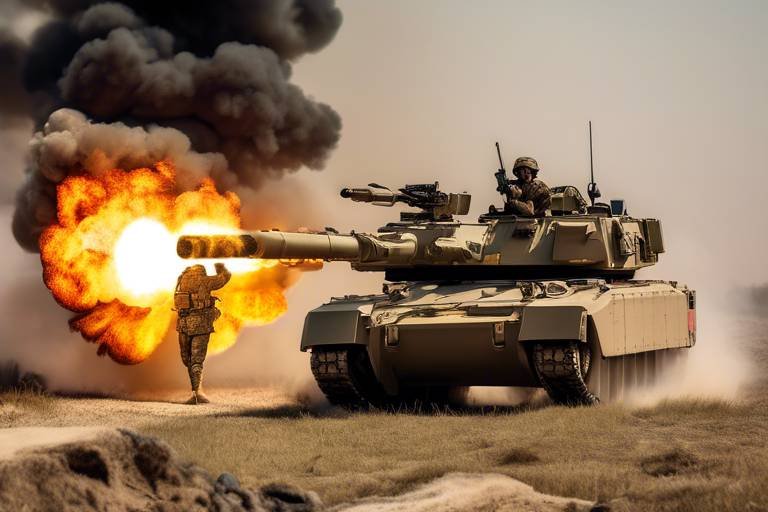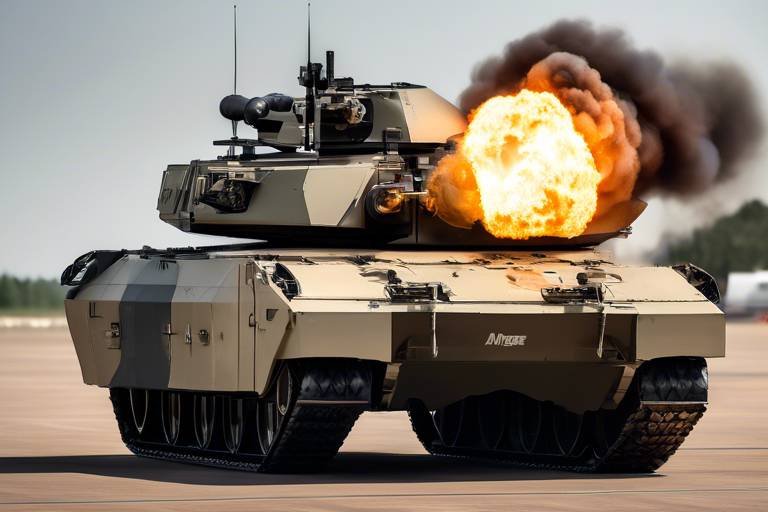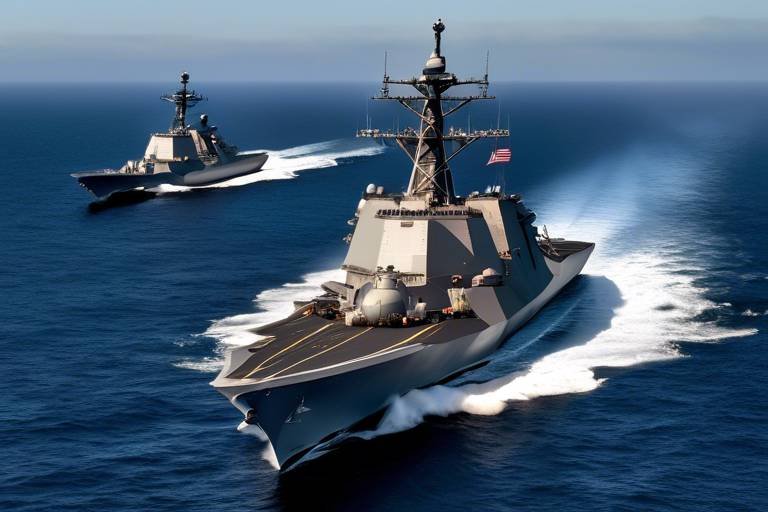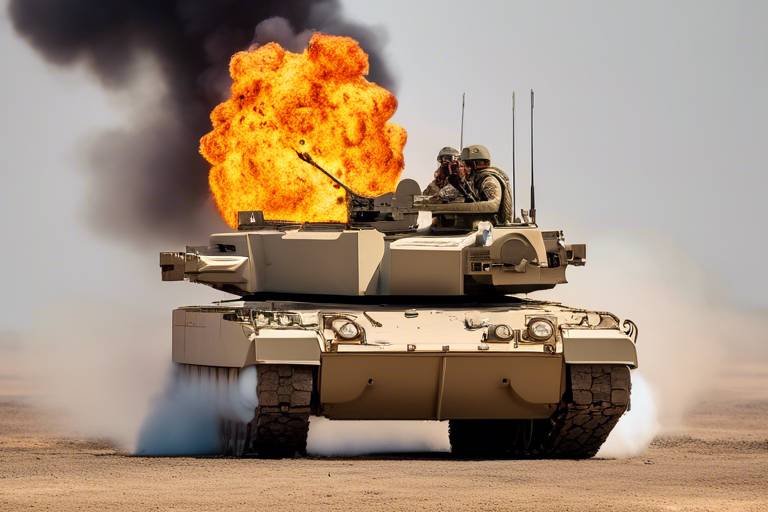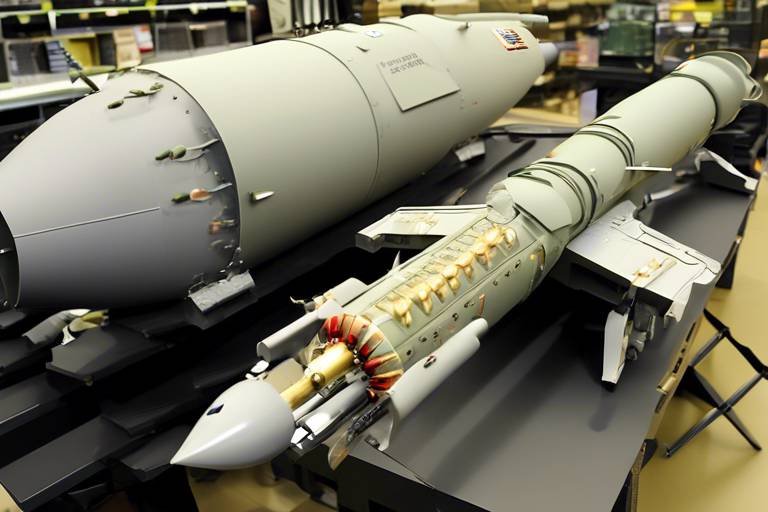The Role of Anti-Tank Guided Missiles in Ground Warfare
In the ever-evolving landscape of modern warfare, the introduction and integration of anti-tank guided missiles (ATGMs) have revolutionized ground combat strategies. These precision-guided weapons have become a game-changer on the battlefield, providing infantry and armored units with the capability to engage and destroy advanced enemy tanks from significant distances. Imagine a soldier, equipped with a missile system that can strike a target several kilometers away, all while remaining hidden from the enemy. This is the power of ATGMs, and it has dramatically shifted the balance of power in ground engagements.
The significance of ATGMs in military operations cannot be overstated. They have not only enhanced the lethality of ground forces but have also forced adversaries to rethink their armored vehicle designs and battlefield tactics. The presence of ATGMs can deter aggressive maneuvers by enemy tanks, as the risk of being hit by a guided missile looms large. In essence, ATGMs have become the spearhead of modern ground warfare, providing both offensive and defensive capabilities that are critical in today’s conflicts.
As we delve deeper into the world of ATGMs, it’s essential to understand their historical context. The journey of these advanced weapon systems began in the mid-20th century, during the Cold War, when the need for effective anti-armor solutions became apparent. Early systems were often cumbersome and lacked the precision that modern technology affords. However, with advancements in guidance systems, materials, and propulsion, ATGMs have evolved into highly effective tools of warfare.
Today, ATGMs are categorized into several types, each with unique operational characteristics. From wire-guided systems that require the operator to maintain visual contact with the target, to laser-guided missiles that can home in on targets illuminated by a laser, the variety is vast. Furthermore, the advent of fire-and-forget technology allows operators to launch missiles and take cover immediately, as the missile autonomously navigates to its target. This evolution in technology has not only improved effectiveness but has also changed the way military strategies are formulated.
As we explore the operational use of ATGMs in recent conflicts, it becomes clear that these weapons have played pivotal roles in various military engagements. For instance, during the conflicts in the Middle East, ATGMs were instrumental in countering armored offensives, allowing smaller units to take on larger formations effectively. The tactical flexibility provided by ATGMs means that even lightly armed infantry can pose a significant threat to heavily armored adversaries.
The impact of ATGMs extends beyond the battlefield; they have also influenced tank design and armor technology. As militaries recognize the threat posed by these guided missiles, there has been a concerted effort to develop countermeasures and enhance armor protection. This arms race between ATGM technology and tank defenses reflects the dynamic nature of military innovation.
In summary, the role of anti-tank guided missiles in ground warfare is multifaceted and critical. They not only enhance the combat effectiveness of ground forces but also compel adversaries to adapt their strategies and technologies. As we continue to witness advancements in missile technology and countermeasures, it is evident that ATGMs will remain a cornerstone of modern military operations.
- What are anti-tank guided missiles?
Anti-tank guided missiles (ATGMs) are precision-guided munitions designed to target and destroy armored vehicles, particularly tanks. - How do ATGMs work?
ATGMs typically use various guidance systems, such as wire guidance, laser guidance, or fire-and-forget technology, to track and hit their targets. - What are the advantages of using ATGMs?
ATGMs offer high accuracy, extended range, and the ability to engage targets from a safe distance, making them invaluable in modern warfare. - How have ATGMs impacted tank design?
The proliferation of ATGMs has led to advancements in tank armor and design, as militaries strive to counter the threat posed by these weapons.
History of Anti-Tank Guided Missiles
The journey of anti-tank guided missiles (ATGMs) is nothing short of fascinating. Emerging from the ashes of World War II, these weapons have transformed the battlefield landscape, making them a critical component of modern warfare. Initially, the concept of guided missiles was more of a dream than reality, but with advancements in technology, this dream became a powerful tool in military arsenals. The first operational ATGM, the Soviet 9M14 Malyutka, also known as the AT-3 Sagger, was introduced in the 1960s. This marked a significant milestone, paving the way for the development of more sophisticated systems.
Throughout the decades, ATGMs have undergone remarkable evolution. The Cold War era saw a surge in military innovations, with nations racing to develop more effective anti-tank systems. The introduction of wire-guided missiles represented a breakthrough, allowing operators to maintain control over the missile's trajectory until impact. However, the limitations of this technology, such as vulnerability to countermeasures and the need for a clear line of sight, led to further advancements.
As we moved into the 1970s and 1980s, the introduction of laser-guided missiles changed the game entirely. These systems allowed for greater accuracy and reduced the likelihood of enemy interference. The FGM-148 Javelin, developed in the late 20th century, epitomized this evolution. It featured a fire-and-forget capability, enabling soldiers to engage targets without remaining exposed to enemy fire. This shift not only improved the effectiveness of anti-tank operations but also influenced military strategies worldwide.
Fast forward to the 21st century, and ATGMs have continued to evolve, integrating advanced technologies such as infrared guidance and multi-target tracking systems. The proliferation of these weapons has prompted a significant shift in how armored vehicles are designed and deployed. Tanks are no longer the invulnerable behemoths they once were; instead, they must adapt to the reality of facing highly mobile, precision-guided munitions.
In summary, the history of anti-tank guided missiles is a testament to human ingenuity and the relentless pursuit of military superiority. As technology continues to advance, one can only wonder what the future holds for these powerful weapons and how they will shape the next generation of ground warfare.
Types of Anti-Tank Guided Missiles
When it comes to anti-tank guided missiles (ATGMs), the variety available today is as diverse as the conflicts they are designed to address. Understanding the different types of ATGMs is crucial for grasping their role in modern warfare. These missiles can be categorized based on their guidance systems, and each type brings unique benefits and challenges to the battlefield. In this section, we will delve into the three primary categories of ATGMs: wire-guided, laser-guided, and fire-and-forget systems.
Wire-Guided Missiles were among the first generation of ATGMs, and they still hold relevance in certain combat scenarios today. These missiles are controlled by a wire that connects the missile to the launch platform, allowing the operator to guide the missile to its target. The operator must maintain visual contact with the target throughout the flight of the missile, which can be a double-edged sword. While this method offers high accuracy, it also exposes the operator to enemy fire. A classic example of a wire-guided missile is the TOW (Tube-launched, Optically tracked, Wire-guided) missile, which has been widely used since the 1970s.
Next up, we have Laser-Guided Missiles. These missiles utilize a laser designator to lock onto targets, enhancing their precision significantly. The operator illuminates the target with a laser beam, and the missile homes in on that reflected light. This type of guidance system allows for a remarkable degree of accuracy, making laser-guided missiles particularly effective against armored vehicles. One notable example is the Javelin missile, which has gained fame for its ability to strike from above, targeting the most vulnerable parts of tanks.
Finally, we have the Fire-and-Forget systems, which represent a technological leap in ATGM capabilities. Once launched, these missiles do not require further guidance from the operator, allowing them to take cover or relocate after firing. This feature is particularly advantageous in fast-paced combat situations where the operator faces immediate threats. The Spike missile system is a prime example of a fire-and-forget ATGM, offering versatility and ease of use.
To summarize the key differences between these missile types, here’s a quick overview:
| Type | Guidance Method | Advantages | Disadvantages |
|---|---|---|---|
| Wire-Guided | Wire connection to launch platform | High accuracy | Operator exposed to fire |
| Laser-Guided | Laser designator | Exceptional precision | Requires operator to maintain target lock |
| Fire-and-Forget | Autonomous guidance | Operator can take cover after launch | May have less precision compared to laser-guided |
In conclusion, the variety of anti-tank guided missiles available today reflects the evolving landscape of ground warfare. Each type of missile brings its own set of strengths and weaknesses, making them suitable for different combat scenarios. As technology continues to advance, we can expect to see further innovations in ATGM systems, enhancing their effectiveness on the battlefield.
Wire-Guided Missiles
Wire-guided missiles represent one of the earliest advancements in anti-tank warfare technology, emerging during a time when conventional tank battles dominated the battlefield. These missiles rely on a physical wire connection between the launcher and the missile, allowing for real-time guidance from the operator. This method of guidance offers a level of control that is both a blessing and a curse. On one hand, the operator can make adjustments mid-flight, ensuring that the missile stays on target. On the other hand, the wire can be easily cut or jammed, making these systems vulnerable to countermeasures.
Historically, wire-guided missiles have been pivotal in numerous conflicts, notably during the Cold War era. The French MILAN and the American TOW missile systems are prime examples of wire-guided technology that have seen extensive use. These systems were designed to penetrate the heavily armored tanks of the time, and they did so with remarkable effectiveness. The operator's ability to track the target visually while guiding the missile provided a significant tactical advantage in urban and close-combat scenarios.
One of the most compelling aspects of wire-guided missiles is their operational flexibility. They can be launched from a variety of platforms, including ground vehicles, helicopters, and even infantry units. This versatility allows military forces to deploy them in diverse environments, enhancing their battlefield effectiveness. However, this advantage comes with a trade-off; the wire tether limits the missile's range and makes it susceptible to enemy fire. As such, operators must be trained to navigate these challenges effectively.
When evaluating wire-guided missiles, it's essential to consider both their advantages and disadvantages:
- Advantages:
- High accuracy due to real-time guidance
- Ability to adjust target mid-flight
- Versatile deployment options
- Disadvantages:
- Limited range due to wire tether
- Vulnerability to jamming and countermeasures
- Requires skilled operators for effective use
In conclusion, while wire-guided missiles have played a significant role in shaping anti-tank warfare, their limitations have led to the development of more advanced systems. As technology continues to evolve, military strategists are always on the lookout for the next big breakthrough in missile guidance. Nevertheless, the impact of wire-guided missiles on military tactics and engagements cannot be overstated—they have paved the way for the more sophisticated anti-tank systems we see today.
Several wire-guided missile systems have left a mark on military history. For instance, the American TOW missile has been a staple in U.S. military operations since the 1970s. Known for its reliability and effectiveness, the TOW has been used in various conflicts, including the Gulf War, where it demonstrated its capability to disable modern tanks from significant distances. Similarly, the French MILAN has been widely exported and used in numerous conflicts, proving its worth on the battlefield.
Advantages and Disadvantages
When it comes to the world of anti-tank guided missiles (ATGMs), understanding their advantages and disadvantages is crucial for both military strategists and enthusiasts alike. These sophisticated weapons systems have revolutionized ground warfare, but they come with their own set of challenges. Let's dive into the pros and cons of ATGMs, particularly focusing on wire-guided missiles as a key example.
One of the most significant advantages of wire-guided missiles is their accuracy. These missiles are connected to the launch platform via a thin wire, allowing for real-time adjustments during flight. This connection ensures that the operator can make fine-tuned corrections to the missile's trajectory, leading to a higher probability of hitting the intended target. In combat scenarios, this level of precision can be the difference between a successful strike and a missed opportunity.
Moreover, wire-guided missiles often have a longer range compared to traditional anti-tank weapons. This extended reach allows for engagements from a safer distance, reducing the risk to the operator and increasing the overall tactical flexibility on the battlefield. Imagine being able to engage a heavily armored tank from a concealed position; this capability can significantly alter the dynamics of a ground operation.
However, it's essential to consider the disadvantages that come with these systems. One major drawback is their vulnerability to countermeasures. As technology evolves, so do the defensive systems employed by armored vehicles. Many modern tanks are equipped with electronic countermeasures designed to disrupt the wire guidance systems of ATGMs. This can lead to a situation where the missile fails to reach its target, rendering the operator's efforts futile.
Additionally, the requirement for a physical connection between the missile and the launcher can impose operational limitations. For instance, if the missile is fired from a moving platform, maintaining the wire connection can be challenging. Any sudden movements or changes in direction can jeopardize the missile's flight path, potentially leading to a missed target or even a friendly fire incident. Thus, while wire-guided missiles offer remarkable accuracy, they also demand a level of operational discipline that can be difficult to maintain in chaotic combat environments.
To sum it up, the effectiveness of wire-guided missiles hinges on a delicate balance between their strengths and weaknesses. They provide exceptional accuracy and range, but their susceptibility to countermeasures and operational constraints cannot be overlooked. As military forces continue to innovate and adapt, understanding these factors will be vital in leveraging the full potential of ATGMs on the battlefield.
- What is an anti-tank guided missile? An ATGM is a type of guided missile specifically designed to hit and destroy armored vehicles, such as tanks.
- How do wire-guided missiles work? Wire-guided missiles are connected to the launch platform via a wire, allowing the operator to guide the missile to its target in real-time.
- What are the main types of ATGMs? The main types include wire-guided, laser-guided, and fire-and-forget systems, each with unique features and tactical applications.
- How do ATGMs impact modern warfare? ATGMs have changed the dynamics of ground combat by providing infantry and smaller units with the capability to engage and destroy armored threats effectively.
Notable Examples
When we talk about anti-tank guided missiles (ATGMs), several notable systems come to mind that have significantly shaped the landscape of modern warfare. One of the most recognized wire-guided missile systems is the FGM-148 Javelin, which has gained fame for its remarkable effectiveness in combat. This missile is not just a piece of technology; it represents a paradigm shift in how ground forces engage armored threats. With its fire-and-forget capability, the Javelin allows operators to engage targets and then reposition quickly, minimizing their exposure to enemy fire.
Another significant example is the SACLOS (Semi-Automatic Command to Line of Sight) missile systems, such as the Milán and Spike. These systems have been pivotal in numerous conflicts, particularly in urban warfare scenarios where precision is paramount. The Milán, for instance, has been employed effectively by various military forces since its introduction in the 1970s, showcasing its durability and adaptability in changing combat environments.
Furthermore, the 9M133 Kornet, a Russian laser-guided missile, has made headlines for its ability to penetrate modern tank armor. Its deployment in conflicts such as the Syrian Civil War highlights its effectiveness against advanced armored vehicles. The Kornet's design allows for a high degree of accuracy, making it a formidable choice for ground forces facing heavily armored opponents.
To give you a clearer picture, let's look at a comparative table of these notable ATGMs:
| Missile System | Type | Guidance System | Year Introduced | Notable Features |
|---|---|---|---|---|
| FGM-148 Javelin | Fire-and-Forget | Infrared | 1996 | High mobility, user-friendly |
| Milán | SACLOS | Wire-guided | 1971 | Proven in numerous conflicts |
| 9M133 Kornet | Laser-guided | Laser Beam Riding | 1994 | Effective against modern armor |
These examples illustrate the diverse capabilities and applications of ATGMs on the battlefield. Each system has its unique advantages, and their development reflects the ongoing arms race between offensive and defensive technologies. As militaries around the world continue to innovate, the effectiveness of ATGMs will likely evolve, further influencing ground warfare tactics.
In summary, the history of ATGMs is rich with technological advancements and strategic implications. The effectiveness of systems like the Javelin, Milán, and Kornet not only showcases the importance of these weapons in contemporary conflicts but also emphasizes the need for continuous adaptation in military strategies to counter emerging threats.
- What are anti-tank guided missiles?
ATGMs are precision-guided munitions designed to hit and destroy armored vehicles. - How do ATGMs differ from traditional anti-tank weapons?
Unlike traditional weapons, ATGMs use advanced guidance systems, allowing for greater accuracy and effectiveness. - What is the significance of wire-guided missiles?
Wire-guided missiles have been crucial in the evolution of anti-tank warfare, offering a balance of range and accuracy. - How do laser-guided missiles work?
Laser-guided missiles rely on laser beams for targeting, ensuring high precision in hitting targets. - What impact do ATGMs have on tank design?
The proliferation of ATGMs has led to innovations in tank armor and design, as militaries seek to mitigate the threat posed by these weapons.
Laser-Guided Missiles
Laser-guided anti-tank guided missiles (ATGMs) represent a significant leap in modern warfare technology, transforming the way battles are fought on the ground. These sophisticated systems utilize laser guidance to strike targets with pinpoint accuracy, making them a formidable asset on the battlefield. The core idea behind laser-guided missiles is relatively simple: a laser designator illuminates the target, and the missile homes in on that laser beam, ensuring that it hits its intended mark. This technology has not only increased the effectiveness of anti-tank operations but has also changed the dynamics of armored warfare.
One of the standout features of laser-guided missiles is their precision. Unlike their wire-guided counterparts, which require a physical connection to the launch platform, laser-guided missiles can engage targets at greater distances without the same level of risk. This capability allows soldiers to remain concealed while launching attacks, thereby enhancing their survivability. Furthermore, the ability to lock onto moving targets significantly enhances the strategic options available to military commanders, allowing for more flexible and responsive operations in dynamic combat environments.
However, the effectiveness of laser-guided missiles does come with some caveats. For instance, they require a clear line of sight to the target, which can be challenging in complex terrains or adverse weather conditions. Additionally, the presence of enemy countermeasures, such as smoke screens or electronic warfare tactics, can disrupt the laser guidance system, potentially leading to missed targets. Nonetheless, the benefits often outweigh these challenges, and militaries around the world have increasingly integrated laser-guided missiles into their arsenals.
To illustrate the impact of laser-guided missiles, let’s take a look at some notable examples that have made headlines in recent conflicts. Systems like the FGM-148 Javelin and the Spike series have proven to be game-changers in various military engagements. These missiles not only boast advanced guidance systems but also have a fire-and-forget capability, allowing operators to engage multiple targets without needing to stay locked onto the initial target. This feature is particularly advantageous in fast-paced combat scenarios where split-second decisions can mean the difference between victory and defeat.
In summary, laser-guided missiles have revolutionized anti-tank warfare by offering unparalleled precision and flexibility. As militaries continue to adapt to the evolving landscape of ground combat, the role of these advanced weapon systems is only expected to grow. Their ability to strike fear into the hearts of enemy tank crews while providing ground forces with a significant tactical advantage cannot be overstated. As technology advances, we can only anticipate even more sophisticated iterations of laser-guided missiles, further solidifying their place in modern military strategy.
Operational Use in Conflicts
Anti-tank guided missiles (ATGMs) have dramatically reshaped the landscape of modern warfare, becoming a pivotal component in numerous conflicts around the globe. Their ability to engage and destroy armored vehicles from a distance has made them invaluable assets on the battlefield. As we delve into their operational use, it’s essential to consider how these advanced weapons have influenced military strategies and outcomes in various theaters of war.
In recent conflicts, ATGMs have been deployed with remarkable effectiveness, often determining the success or failure of military operations. For instance, during the Syrian Civil War, both government and rebel forces have utilized ATGMs to counter heavily armored vehicles, leading to significant shifts in combat tactics. The presence of these missiles has forced tank crews to rethink their traditional roles and adopt more defensive postures, often relying on cover and mobility to avoid detection and engagement.
One of the most striking examples of ATGM effectiveness can be observed in the 2020 Nagorno-Karabakh conflict. Here, Azerbaijani forces employed a range of modern ATGMs, including the Israeli-made Spike and the American Javelin, to devastating effect against Armenian tanks. The results were staggering, with numerous armored units being destroyed or rendered ineffective within a short period. This conflict highlighted not only the firepower of ATGMs but also their ability to alter the balance of power on the battlefield, making them a game-changer in contemporary warfare.
Furthermore, the operational use of ATGMs has led to a transformation in the way military forces approach ground engagements. Commanders now prioritize the integration of ATGMs into their tactical planning, often using them in combination with drones and other reconnaissance assets to maximize their effectiveness. This multi-dimensional approach allows for precise targeting and minimizes the risk to personnel, as operators can engage from concealed positions, often miles away from the frontline.
To illustrate the impact of ATGMs on military strategies, consider the following table showcasing key conflicts where ATGMs played a crucial role:
| Conflict | Year | ATGM Used | Outcome |
|---|---|---|---|
| Syrian Civil War | 2011-Present | 9M133 Kornet | Significant losses for armored units |
| Nagorno-Karabakh | 2020 | Spike, Javelin | Azerbaijani victory, heavy losses for Armenian forces |
| Yemen Civil War | 2014-Present | AT-3 Sagger | Increased effectiveness of Houthi forces |
In addition to changing military tactics, the proliferation of ATGMs has also led to significant advancements in tank design and armor technology. Armored vehicle manufacturers are now compelled to innovate, developing reactive armor and active protection systems to counter the threat posed by these missiles. The arms race between ATGM capabilities and tank defenses continues to evolve, as each side seeks to gain the upper hand.
As we look to the future, it’s clear that ATGMs will remain a critical element in ground warfare. Their operational use in recent conflicts underscores their importance in modern military strategy, and it’s likely that we will see further developments in both missile technology and countermeasures as nations adapt to this ever-changing battlefield landscape.
- What are anti-tank guided missiles? - ATGMs are precision-guided munitions designed to target and destroy armored vehicles.
- How do ATGMs differ from traditional anti-tank weapons? - Unlike traditional weapons, ATGMs use advanced guidance systems for greater accuracy and range.
- What impact do ATGMs have on tank warfare? - They force tank operators to modify their tactics, often prioritizing mobility and concealment to avoid detection.
- Are ATGMs effective against all types of armored vehicles? - While highly effective, their success can depend on the type of armor and countermeasures employed by the target.
Case Studies
The deployment of anti-tank guided missiles (ATGMs) has significantly altered the landscape of modern warfare, making them essential tools in various military operations. Let's delve into some notable case studies that illustrate the effectiveness and strategic importance of ATGMs in combat scenarios.
One of the most prominent examples is the use of ATGMs during the Yom Kippur War in 1973. The Israeli Defense Forces faced a formidable challenge from Egyptian armor, which was bolstered by Soviet-made tanks. The introduction of the FGM-148 Javelin missile system by the Israeli forces proved to be a game-changer. The Javelin's fire-and-forget capability allowed operators to engage enemy tanks from concealed positions, minimizing exposure to return fire. This tactical advantage not only resulted in significant tank losses for the Egyptians but also showcased how ATGMs could redefine battlefield engagements.
Another compelling case is the conflict in Ukraine, where ATGMs like the Spike and the Javelin have been extensively utilized. Ukrainian forces effectively employed these missiles against Russian armored columns, highlighting the strategic shift in ground warfare. Reports indicate that the use of these advanced systems led to the destruction of numerous armored vehicles, showcasing the effectiveness of ATGMs in asymmetric warfare. The ability to strike from a distance and the precision of these systems have proven invaluable in countering superior tank forces.
Furthermore, during the Gulf War in 1991, the U.S. military's use of the TOW (Tube-launched, Optically tracked, Wire-guided) missile system against Iraqi tanks demonstrated the operational impact of ATGMs. With their ability to penetrate heavy armor, TOW missiles were instrumental in neutralizing the threat posed by Iraqi armored divisions. The success of these missiles not only contributed to the rapid defeat of Iraqi forces but also underscored the importance of integrating ATGMs into modern military strategies.
To summarize, these case studies reveal the pivotal role that ATGMs play in contemporary warfare. They not only enhance the lethality of ground forces but also force adversaries to rethink their armor strategies. The effectiveness of ATGMs in various conflicts underscores their significance in shaping military outcomes and operational tactics.
- What are anti-tank guided missiles (ATGMs)?
ATGMs are precision-guided munitions designed to hit and destroy armored vehicles, such as tanks, using various guidance systems. - How do ATGMs differ from traditional anti-tank weapons?
Unlike traditional weapons, ATGMs employ advanced guidance systems, allowing for greater accuracy and the ability to engage targets from a distance. - What are some common types of ATGMs?
Common types include wire-guided missiles, laser-guided missiles, and fire-and-forget systems, each with unique operational characteristics. - How have ATGMs influenced modern tank design?
The proliferation of ATGMs has led to advancements in tank armor technology, as militaries seek to mitigate the threat posed by these powerful weapons.
Impact on Tank Design
The emergence and proliferation of anti-tank guided missiles (ATGMs) have significantly transformed the landscape of armored warfare, compelling military engineers and designers to rethink tank designs from the ground up. In a world where tanks once roamed the battlefield with a sense of invulnerability, the rise of ATGMs has ushered in a new era of vulnerability that has forced militaries to innovate and adapt. This adaptation is not merely a reaction; it’s a necessity driven by the relentless advancement of anti-tank technology.
One of the most notable impacts of ATGMs on tank design is the increased emphasis on active protection systems (APS). These systems are designed to detect incoming threats, such as missiles, and neutralize them before they can strike. For example, the Israeli Merkava tank series has incorporated APS like the Trophy system, which can intercept and destroy incoming projectiles. This shift towards integrating APS into tank designs reflects a broader trend of enhancing survivability against modern threats.
Moreover, the armor composition of tanks has evolved significantly. In response to the effectiveness of ATGMs, manufacturers have started using advanced composite materials and reactive armor. Reactive armor, which explodes outward upon impact, can disrupt the penetration of an incoming missile. This innovation not only increases the survivability of the tank but also changes the way tanks are deployed in combat scenarios. For instance, tanks are now often used in conjunction with infantry and other support units to minimize exposure to ATGMs.
Another critical aspect influenced by ATGMs is the mobility and agility of tanks. Traditionally, tanks were designed for brute force and firepower, often prioritizing weight over speed. However, the threat posed by ATGMs has led to a re-evaluation of this philosophy. Modern tanks are now being designed with lighter materials and enhanced suspension systems to improve their maneuverability, allowing them to quickly reposition and evade threats. This shift not only helps in avoiding missile strikes but also facilitates better battlefield tactics, as tanks can now engage targets from advantageous positions.
| Tank Design Feature | Impact of ATGMs |
|---|---|
| Active Protection Systems | Neutralize incoming missiles before impact |
| Reactive Armor | Disrupt penetration of ATGMs |
| Mobility Enhancements | Improved maneuverability to evade threats |
Furthermore, the integration of technology into tank warfare has also seen tanks equipped with advanced sensors and targeting systems, enabling them to detect and engage ATGM launchers at greater distances. Tanks are now equipped with battle management systems that allow them to communicate effectively with other units on the battlefield, creating a synergistic effect that enhances overall combat effectiveness. This level of integration is crucial, as it allows tank crews to be more aware of their surroundings and react quickly to potential threats.
In conclusion, the impact of ATGMs on tank design is profound and multifaceted. As these anti-tank systems continue to evolve, so too must the designs of tanks to ensure they remain relevant and effective on the modern battlefield. The ongoing arms race between ATGMs and tank technology is a testament to the dynamic nature of military innovation, where each advancement prompts a counter-response, shaping the future of ground warfare.
- What are anti-tank guided missiles (ATGMs)?
ATGMs are precision-guided munitions designed specifically to target and destroy armored vehicles. - How have ATGMs changed tank warfare?
They have made tanks more vulnerable, leading to innovations in tank design and the incorporation of active protection systems. - What is reactive armor?
Reactive armor is a type of armor that explodes outward upon impact to disrupt the penetration of incoming projectiles. - Can tanks still be effective against ATGMs?
Yes, with advancements in technology, tanks can still be effective, especially when equipped with modern protection systems and mobility enhancements.
Frequently Asked Questions
- What are Anti-Tank Guided Missiles (ATGMs)?
Anti-Tank Guided Missiles, or ATGMs, are advanced weapon systems designed specifically to destroy armored vehicles, particularly tanks. They utilize various guidance systems to accurately strike their targets, making them a crucial element in modern ground warfare.
- How have ATGMs evolved over time?
The evolution of ATGMs has been remarkable. From early wire-guided systems to today's sophisticated fire-and-forget missiles, technological advancements have significantly enhanced their accuracy, range, and effectiveness in combat scenarios. This evolution reflects the ongoing arms race between offensive and defensive military technologies.
- What are the different types of ATGMs?
ATGMs can be categorized into several types, including wire-guided, laser-guided, and fire-and-forget systems. Each type has its unique features and applications. For instance, wire-guided missiles require a physical connection to the launcher, while laser-guided missiles rely on targeting lasers for precision strikes.
- What are the advantages and disadvantages of wire-guided missiles?
Wire-guided missiles offer high accuracy and can be guided throughout their flight. However, they are susceptible to countermeasures and have limited range due to the physical connection. This creates a tactical dilemma where operators must balance the benefits of precision against the risks posed by enemy defenses.
- Can you give examples of notable wire-guided missile systems?
Some significant wire-guided missile systems include the Soviet-made 9M14 Malyutka and the American TOW missile. These systems have been pivotal in various conflicts, showcasing their effectiveness against armored targets and influencing anti-tank warfare tactics.
- What impact have ATGMs had on tank design?
The proliferation of ATGMs has prompted significant innovations in tank design and armor technology. Manufacturers are continuously developing better armor solutions and defensive systems to counter the threat posed by these missiles, leading to a cycle of adaptation in military technology.
- How are ATGMs used in modern conflicts?
In recent conflicts, ATGMs have played a crucial role in shaping battlefield strategies. Their ability to engage and destroy armored vehicles from a distance allows infantry units to counter heavier forces effectively, altering the dynamics of ground engagements.
- What are some case studies illustrating the effectiveness of ATGMs?
Case studies from conflicts such as the Gulf War and the Syrian Civil War highlight the critical role of ATGMs. In these scenarios, ATGMs proved decisive in ambushing enemy tanks and altering the course of battles, demonstrating their strategic importance in modern warfare.







